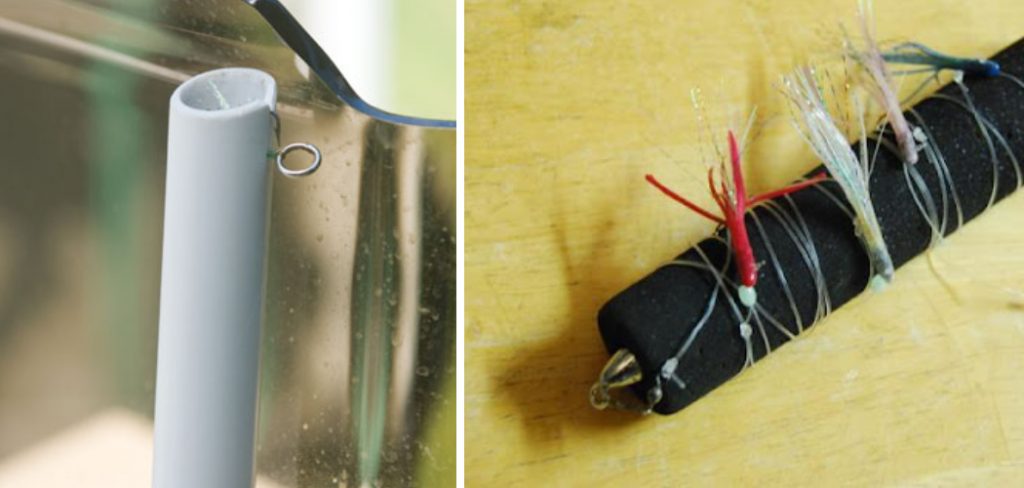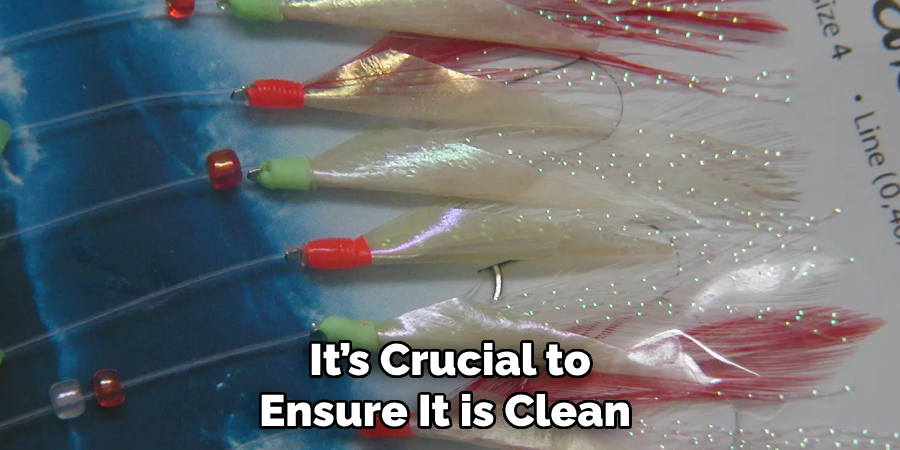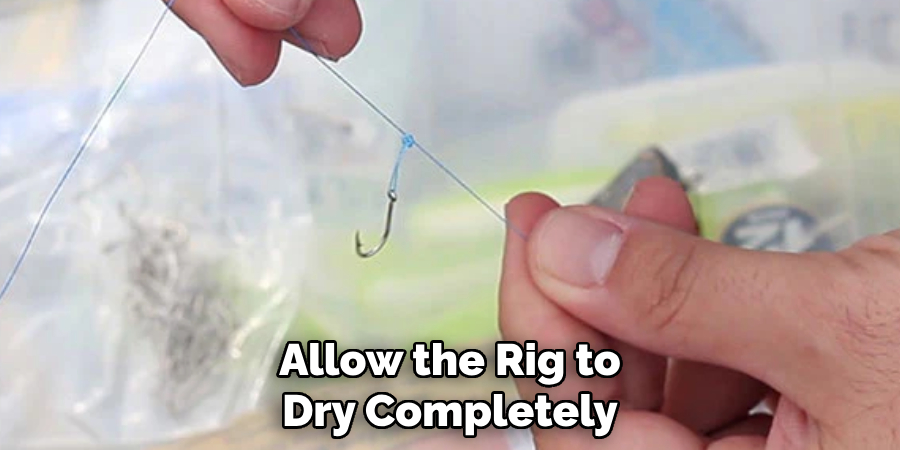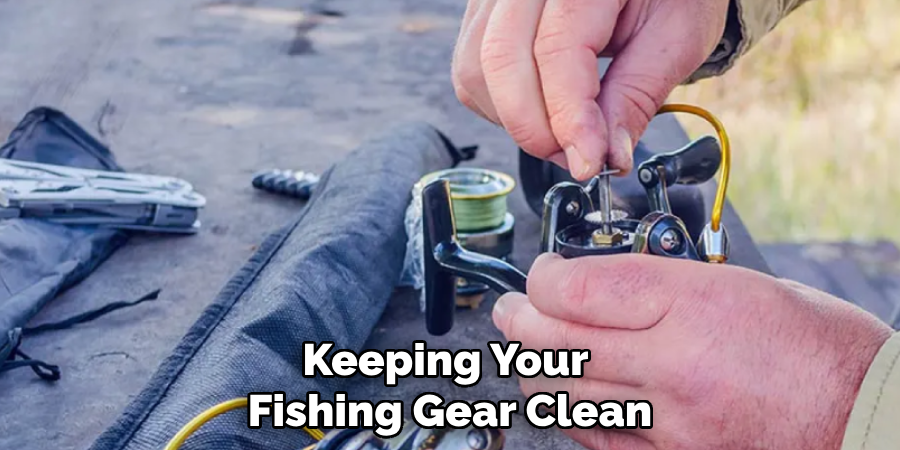Are you tired of getting tangled up in your sabiki rig every time you go fishing? Don’t worry, we’ve got you covered! In this guide, we’ll teach you how to store a sabiki rig so that it stays tangle-free and ready for use.
Storing a Sabiki rig properly ensures its longevity and prevents unnecessary tangles or damage. Sabiki rigs are a popular choice for anglers catching baitfish, but their tiny hooks and delicate lines can quickly become a hassle if not stored carefully.

Using the proper storage techniques, you can keep your rig organized and ready for your next fishing trip, saving time and frustration. Let’s dive into some tips and tricks for storing a sabiki rig effectively.
What Will You Need?
Before we get into the storage methods, here are some essential items that you will need:
- A plastic tube or PVC pipe
- Rubber bands or cable ties
- Fishing line spool holder
- A dry and cool place to store your rig
Once these items are ready, follow the steps below to store your sabiki rig efficiently.
10 Easy Steps on How to Store a Sabiki Rig
Step 1: Remove any Bait or Debris
Before storing your sabiki rig, it’s crucial to ensure it is clean and free of any remnants of bait or debris. Leftover bait can attract unwanted pests, lead to unpleasant odors, and even cause the hooks or lines to corrode over time. To clean the rig, gently rinse it in freshwater, paying special attention to the hooks and lines.
If bait remnants are stuck on the hooks, carefully remove them using a cloth or your fingers, taking care not to prick yourself. Once all debris is removed, pat the rig dry with a soft towel to prevent moisture-related damage. Ensuring that your sabiki rig is clean and dry is the first step in maintaining its condition for future use.

Step 2: Detangle the Rig
After cleaning, detangle your sabiki rig carefully to prevent knots and ensure smoother handling when you use it next. Begin by extending the rig fully and identifying areas where the lines have tangled.
Use your fingers or a small tool, such as a needle or toothpick, to gently loosen the knots without pulling too hard, as this could damage the line. Work methodically from one end of the rig to the other, ensuring that each section is straightened and free from entanglement. A detangled rig saves time during your next fishing trip and reduces the risk of weakened or damaged lines.
Step 3: Inspect for Damage
Once your sabiki rig is clean and detangled, carefully inspect it for any signs of damage. Check the mainline and branch lines for fraying, cuts, or weak spots that could lead to breakage. Examine the hooks to ensure they are sharp and not bent, as damaged hooks can decrease your chances of a successful catch.
Additionally, inspect any swivels or connectors for rust or deformation, as these components are vital for the rig’s functionality. If you notice any issues, replace the damaged parts promptly to avoid complications during your next fishing outing. Proper inspection ensures that your sabiki rig remains reliable and ready for use.
Step 4: Store the Rig Properly
Proper storage is essential to maintain its condition after cleaning, detangling, and inspecting your sabiki rig. Start by carefully coiling the rig around a suitable holder, such as a foam spool or a dedicated rig storage board, to prevent tangling.

Secure the hooks by embedding them into the holder to keep them from snagging on other gear. Store the rig in a cool, dry place away from direct sunlight to avoid deterioration of the line or hooks. Proper storage not only prolongs the life of your rig but also ensures it is organized and ready for quick deployment during your next fishing adventure.
Step 5: Replace Worn-Out Components
Over time, specific components of your sabiki rig, such as hooks, lines, or swivels, may show signs of wear and tear. Regularly inspect these parts for rust, fraying, or general degradation. Replace any worn-out hooks with sharp, corrosion-resistant ones to maintain the rig’s effectiveness.
Similarly, swap out damaged lines or swivels to ensure the rig remains sturdy and functional. By replacing worn-out components as needed, you can extend the lifespan of your sabiki rig and ensure it performs optimally during each fishing trip.
Step 6: Practice Safe Handling
When using a sabiki rig, it is essential to practice safe handling to avoid potential injuries. The rig consists of multiple hooks, which can easily snag on clothing, skin, or other nearby objects if not managed carefully.
Always handle the rig cautiously, keeping the hooks and lines under control to prevent accidents. Use a designated rig holder or storage device to minimize risk when transporting or preparing the rig. By prioritizing safety, you can focus on enjoying a smooth and successful fishing experience.
Step 7: Store Your Rig Properly
Proper storage of your sabiki rig is crucial to maintaining its functionality and preventing tangles or damage. After your fishing trip, rinse the rig with fresh water to remove any salt, dirt, or debris that could cause corrosion or weaken the line.
Allow the rig to dry completely before storing it in a rig holder, tackle box, or designated container. Organizing your rig carefully ensures it will be ready for use on your next outing, saving you time and frustration. Investing in good storage habits prolongs the life of your gear and keeps your fishing setup in top condition.

Step 8: Maintain Your Rig
Regular inspection and maintenance of your sabiki rig are essential to ensure consistent performance and longevity. Before each fishing trip, carefully examine the rig for signs of wear, such as frayed lines, bent hooks, or damaged components. Replace any worn or compromised parts to avoid equipment failure during use.
Additionally, consider sharpening the hooks to maintain their effectiveness in catching fish. Proper maintenance routines enhance your rig’s durability and improve your overall fishing success.
Step 9: Dispose of Worn-Out Rigs Responsibly
When your sabiki rig is no longer usable, it’s essential to dispose of it responsibly to protect the environment. Cut the rig into smaller pieces to prevent wildlife from becoming entangled in the hooks or fishing line.
Ensure the discarded materials are placed in a designated waste bin or taken to a recycling facility if applicable. Practicing proper disposal methods helps preserve aquatic ecosystems and demonstrates a commitment to sustainable fishing practices.
Step 10: Enjoy Your Fishing Experience
Following these steps ensures that your sabiki rig remains in excellent condition for each fishing trip. Keeping your gear clean, detangled, and well-maintained saves time and frustration and increases your chances of a successful catch. Always practice safe handling and proper storage to prolong the life of your rig and make the most out of every fishing expedition.
By following these tips and techniques, you can become a master at caring for your sabiki rig and enjoy a hassle-free fishing experience every time.
5 Things You Should Avoid
- Leaving the Rig Tangled: Avoid tossing your sabiki rig into your tackle box or storage area without properly securing it. Tangled rigs can damage the hooks and lines, making them less effective during your next outing.
- Exposing it to Moisture: Storing your sabiki rig in a damp environment can lead to rust on the hooks and degradation of the line. Always dry the rig thoroughly before putting it away.
- Using Open Hook Storage: Avoid leaving the hooks exposed or uncovered. This makes them prone to damage and increases the risk of injury when handling the rig.
- Ignoring Proper Labeling: If you store multiple sabiki rigs together, avoid placing them in unlabeled or disorganized containers. This can lead to confusion during fishing trips and wasted time sorting through rigs.
- Failing to Use a Rig Holder or Organizer: Storing sabiki rigs loosely without a designated holder can lead to unnecessary wear and tear. Invest in a rig holder or organizer to keep your rigs in good condition and ready for use.
By avoiding these common mistakes, you can prolong the lifespan of your sabiki rig and ensure its effectiveness during your fishing trips.
Should You Bait a Sabiki Rig?
Whether or not you should bait a sabiki rig depends on the type of fish you are targeting and the local fishing conditions. Typically, sabiki rigs are designed to mimic small baitfish or shrimp, which is an effective attractant for many predatory fish. The small, colorful hooks are often adorned with feathers, beads, or other flashy materials that catch the attention of species like mackerel, sardines, and herring without additional bait.

However, adding bait to a sabiki rig can significantly enhance its effectiveness in certain situations. For instance, when fish are less active, or the water is murky, the added scent and movement from small pieces of bait, such as squid, shrimp, or cut fish, can draw attention and encourage strikes. Baiting the hooks can be particularly advantageous when targeting larger or more selective species that might otherwise ignore the artificial appearance of the hooks.
On the other hand, using bait on a sabiki rig also comes with potential drawbacks. It can make the rig messier and more time-consuming to set up. Additionally, bait increases the likelihood of attracting smaller, less desirable species or even nuisance fish like crabs. For this reason, it’s essential to assess the local fishing environment and the behavior of the target species before deciding whether to bait your sabiki rig or use it as intended.
Conclusion
How to store a sabiki rig is essential to maintain its functionality and longevity. One of the most effective methods is to use a dedicated sabiki rig holder or a cylindrical rig storage tube to prevent the hooks and lines from tangling.
Alternatively, you can wrap the rig around a foam or cardboard, securing the hooks into the material for organization. Ensure the rig is rinsed with fresh water after use, especially in salt water, to prevent corrosion and prolong the life of the hooks and lines.
Storing your sabiki rig appropriately saves time and avoids frustration during your next fishing trip.
About the Author
Jennifer Branett is the author of Fishy Kayak and an expert in fish-related fields, with over 10 years of experience. Her work blends passion for fishing with a commitment to conservation.
Educational Background
Degree: Bachelor’s in Marine Biology
Institution: University of California, Santa Barbara
Specializations: Aquatic ecosystems, fish behavior, and sustainable practices
Professional Experience
Conservation Projects:
Collaborated with local organizations to restore aquatic habitats
Developed educational programs on sustainable fishing practices
Publications:
Authored articles for fishing magazines and environmental journals
Featured speaker at fishing expos and conservation conferences
Key Areas of Expertise
Fishing Techniques:
Kayak fishing strategies
Freshwater and saltwater fishing methods
Environmental Stewardship:
Advocacy for sustainable fishing
Promoting biodiversity in aquatic environments
Awards and Recognition
Recipient of the [Specific Award Name] for contributions to marine conservation
Recognized as a leading voice in the fishing community by [Organization/Publication Name]
Community Engagement
Workshops and Seminars:
Regularly hosts events to educate anglers on sustainable practices
Engages with youth programs to inspire the next generation of fishers
Online Presence:
Maintains an active blog sharing tips, stories, and conservation efforts
Engages with followers on social media to promote fishing ethics
Personal Interests
Enjoys kayaking in scenic locations
Passionate about photography, capturing the beauty of nature
Advocates for local conservation efforts in her community
